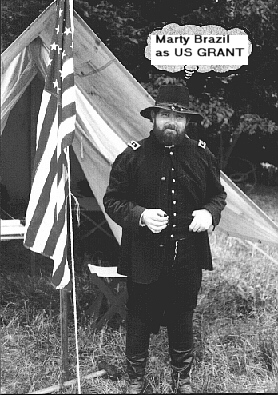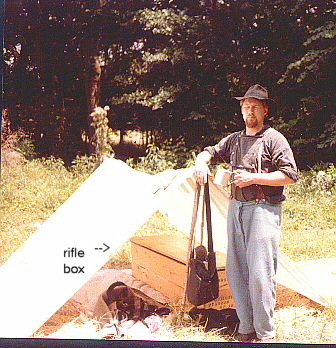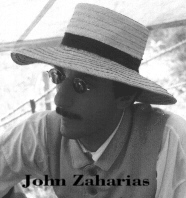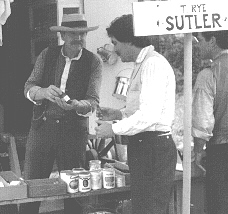|
|
|
By New Year's Day 1982, I had become a father, helped create a reenactment unit in Kansas City, and (besides attending some rather colorful civil war events in and around the state) had also been part of a Made-For-TV Movie. Over the next 12 months, I'd campaign with Grant, witness the birth of the Ladies Union Aid Society, put another stripe on my sleeve, have a battle in a parking lot, and be a pen pal to a civil war reenactor in the United Kingdom.
| |||||||
|
|
|
| |||||
|
| |||||||

It was sometime during the previous year, not long after forming the 18th Missouri, that I wrote back to Prof. Leslie Anders at CMSU. In my letter, I told him he had indirectly influenced me into becoming a civil war reenactor through his lectures and, in particular, his question's about civil war ancestry causing me to pursue genealogy. I told him about naming our unit the 18th Missouri after his regimental history book. In a return letter, he admitted he was both honored and flabbergasted that I had taken his lectures to such an extreme. He also told me of another letter he had recently received from some men in England. It seems the "limey's" over there decided the American Civil War had more "sex appeal" than the English Civil War, so they endeavored to become reenactors themselves. One particular group of Englishmen had even decided to call "themselves" the 18th Missouri. Inquiries into the regimental history of the 18th, caused their letter to fall on the desk of Leslie Anders, Professor of History at CMSU.
(This photo of the 18th Missouri, U.K. was attached to the letter Prof. Anders sent me. Notice the 2 banded muskets and the saber bayonets. An address on the back of this photograph led me to begin a correspondence with Mr. Brian Alan Warwick of Cambridge England. Eventually, Brian did travel to the states, did pay a visit to Prof. Anders, and fell into the ranks with the Holmes Brigade at Fort Scott, KS in May 1984).
I soon came to realize that becoming a reenactor didn't just mean shooting guns or marching in parade. When 20th century clad spectators visited the camps, they usually had questions about ourselves and our equipment. Some of the guys had ready made responses to most questions including assuming the persona of a typical soldier from the 1860's. For a long time, I was uncomfortable with this form of living history. Usually the fellow who had done the most book reading on the Civil War would step forward and lecture on camp life, politics in 1860, personal views of slavery, fighting lice, what type of employment was done before the war, and/or family life. This type of interpretation was known as "first person"; making the public feel as they are actually talking with a visitor from the past.
When recreating a battle on an actual site we would commonly pick one regiment who had been on that battlefield, sometimes choosing an individual name if a roster was available. While reading Prof. Leslie Anders' work on the 18th Missouri, I was determined to absorb as much knowledge about the regiment and some of its men so I could be more comfortable about giving my own "first person impression". Included in the regimental history were several photos of soldiers who had served with the 18th, including the brothers Vincent and Quincy Bruce. One had been a lieutenant, the other a corporal. So it was the later brother that I began to model myself after, and from that moment on (at least during the decade of the eighties), instead of Bob Talbott I became known by both Union and Confederate reenactors, as QUINCY BRUCE.
However, our association with the name 18th Missouri was short lived. As stated earlier, we were forming the HOLMES BRIGADE. The original brigade consisted of the regiments: 10th Missouri, 24th Missouri, 80th Ohio, 56th Illinois, and the 17th Iowa. Dick Stauffer, Higginbotham, and others thought it would be "cool" if the Kansas City Federals would change their unit designation to the 10th Missouri. It was no big deal to me, but I felt a need to make some sort of apology to Prof. Anders and the "blokes" over in England. Again it was only a number. But I did continue to call myself Quincy Bruce. I refused to lose that.
I believe 1982 was the year Holmes Brigade really got going. That September night in Fort Davidson, back in '80, we merely broke the ground. We were still stretching our legs in '81, although at a few events we began to leave our mark; kind of like a dog leaving his scent on a tree. By the end of '82 our conduct on the field had made a satisfying and lasting impression on both the state and local levels. After '82, communities began to seek us out because of our passion for authenticity and dependability. 1982 was truly a milestone year for Holmes Brigade.
April 2-3, 1982 St. Joseph, Missouri
Billed as a living history event only, St. Jo was the birthplace of the Pony Express, and we set up camps near the Patee House Museum. The museum housed all sorts of relics from the Pony Express Days, plus it also contained some Jesse James memorabilia. One hundred years ago exactly, Jesse had been murdered in his home by "that dirty little coward". The home he and his family were living in at the time still stood about a half block away. The home was open to visitors and one could see the bullet hole in the wall (after it passed through Jesse's head). A group of local actors had a play inside the museum depicting the last days and the murder of Jesse. A trio of musicians ended the drama with a song written about the murder.
We discovered a strip club called PLAYERS while visiting downtown St. Jo. that Friday night. The women were, to put it mildly,a little past their prime. Most had stretch marks or their boob's hung like tennis balls in sweat sock's. They disrobed to pasties and a g-string, but it was entertainment nonetheless. The girls danced to loud rock music. They all had some sort of routine, but one had a thing for veils; spinning round and round, the veils twirling above her like a multi-colored tornado. I know representatives of both the Blue and the Gray visited PLAYERS on one occasion or another. Sometime's a reenactor would hand the girl his hat, and she would attempt to stuff her titties in it.
The temperature in early April was cool, especially at night when a bit of snow fell and frost clung to the tent. I think I had my great coat by then; if I did I'm sure I had it on that crisp morning. Throughout the early morning hours, many reenactors remained "bundled-up" with coats, mufflers,and wool mittens. Other than the above mentioned activities we might have drilled, but no battle was fought.
 April 24-25 Higginsville, MO
April 24-25 Higginsville, MO
With the advent of the Holmes Brigade Fund, as mentioned previously, some questions arose as what to use the money for. Kitchen items such as pots, lard buckets, dutch ovens, water barrels, and even hardtack became available using money from the fund. A much larger project was in store when Dick Stauffer along with Bill Fannin made the proposal to have a brigade flag made. By unanimous consent by all the members, construction began over the winter of '81-'82. I gave Dick the balance of $55 from the Holmes Brigade account, plus I believe the hat was passed around as well. At the Higginsville event, the colors were officially presented to the Brigade. It was a magnificent flag! Dick had acquired real silk from a fabric shop in Columbia. It was basically the Stars and Stripes, but all 34 stars had been painted with real gold paint. It measured about 5' x 6' with gold fringe edging and an original Civil War flag tip that was donated from a private collection. The stars in the blue field were arranged in an oval- referring to an original flag that was in the state museum at the Missouri State Capitol Building in Jeff City. A brief scene was enacted in which the loyal ladies of the area (several Holmes Brigade wives) came forward with it, claiming that they had made this flag for us as we prepared to march off to war. The spokeswoman, Kathy Fannin-wife of Bill- gave a patriotic speech followed by an equally moving one by Captain Dick. Don Kling became the first official color sergeant. (The flag remained with the Brigade for seven years, until an accidental fire destroyed it.)
This photo is from an Oct. 1987 event in Weston, MO. The rips in the flag came from a Prairie Grove, Ark. event.
May 15-16 Champion's Hill, MS
In January, the MCWRA had had its annual board meeting and proudly announced that we had been invited to return to Dixie. Dick Stauffer, Ray Ham, and others from the area had gone to the previous Champion Hill of '81, and spoke of things like cactus plantations, fish fry's, and campaigning with Grant. I was unable to attend then, (I believe it was because I hadn't any vacation time to take, being on the job just under a year), but in 1982, I did have the time to take so I resolved to take a 4 day weekend to go to "de land of cotton".
$54 per person would pay for the charter bus and it was hoped there'd be enough people going to make the trip worthwhile. Unfortunately, only myself, John Maki, and Erik Hansen were the only representative's from the Holmes Brigade at this event. Don't remember why Dick Stauffer or any other boys from Holmes weren't going this time. Even Hig couldn't go. The three of us made plan's to fall in with the 1st Colorado boys.
John Maki had started building boxes about this time. He had visited the STEAMBOAT BERTRAND museum up near Omaha, NE. (Sometime in the mid-1800's, this steamboat had been on its way up the Missouri river when it struck a sandbar and sank. One hundred years later, its remains had been discovered and its cargo salvaged. Clothing, nails, bottles, buttons, hats, all in pristine condition; and most still in boxes.) Maki became infatuated with the manufacture of the wooden boxes and their stenciling. He built several bread boxes, some boxes that might hold 16 oz. wine bottles, and a large rifle box. This rifle box measured some 5 feet long, by 2 feet wide, by 2 feet deep. He proposed that when it came time to load the cargo bay of the bus, for the trip to Mississippi, we'd have all our gear and muskets in this box rather than scattered amongst all the "johnny" stuff. We knew that they were notorious for bringing rope beds, mountain man chairs, and tables, plus wall tents (and they did). One thing the "johnnies" don't know how to do is travel light.
From Bannister Mall in Kansas City, the plan was for the bus to drive all
night Thursday (changing drivers once) through Springfield, Little Rock, and
into Vicksburg by Friday afternoon. Once in Vicksburg, we'd tour the National
Park till evening, then the bus would continue another hour east till we reached
Champion's Hill. (Regarding the bus, mention should be made that it wasn't
designed for relaxation, so most of the travelers attempted to occupy themselves
during the 12 hour journey by getting 'corned!'. I don't know how many cases of
beer were consumed during the entire trip, but the empties rolled along the
floor of the bus all night.)
After going through the Ozarks, deep into the heart of Arkansas, and parts of Louisiana, we finally crossed the river Mississippi into the state of Mississippi about 12 noon. I will not insult the reader by giving a history lesson of the siege of Vicksburg. Even the most elementary of civil war scholars know of the campaign conducted by Union General U.S. Grant which culminated in the surrender of Confederate forces on July 4th, 1863. While the actual campaign covered many months and many miles; the site of the "siege", which began in late May 1863 was now part of the National Park system.
The visitor's center was the first stop for us beer-soaked, bleary-eyed travelers - a trip to the restroom a high priority. After a brief toilet, time was spent looking over the many battlefield relics, or painting, maps, and photos that were on display. A look at the slide show in the auditorium and a browse through the gift shop, then it was back on the bus for the driving tour.
The Vicksburg National Military Park was established in 1899 and included 20 miles of reconstructed trenches and earthworks, a 16 mile tour road, and over 1,000 monuments and/or markers. Every State (whether North or South) that lost a son to Vicksburg was represented by some sort of monument. As Missouri had boys that fought in both the Blue and the Gray at Vicksburg, there were 2 monuments from that State. As far as the appearance of these markers, some were flat slabs of marble with names or the face of some brigade commander carved in them. Some were large 20 foot tall statues of a Union or Confederate General on horseback. Then there was the ridiculous. The State of Kansas donated a sculpture of modern art. It looked like silver pipe cleaners twisted into a 7 foot tall pretzel. It got the biggest laugh of the morning! What an embarrassment for Kansas.
We got out of the bus occasionally to examine the trenches or one of the 144 cannon scattered about. The last stop on the tour was the USS CAIRO display. Sunk in 1862, the wood and iron gunboat had been recovered one hundred years later, and lay on a concrete platform near the Mississippi River. It was protected overhead by a huge metal awning, but was open on all sides. The wood was mostly deteriorated or gone, but all the iron parts were intact. A wood skeleton frame had been built to give the visitor an idea of what it might have looked like with the metal bolted back into place. One could see the boiler, guns, anchor, propeller,etc. A building nearby housed some of the many personal items recovered from the wreck of the CAIRO: mess gear, clothing, shoes; somewhat like the STEAMBOAT BERTRAND up in Nebraska. Definitely the highlight of the Vicksburg Park tour.
Well, it's time to stop stalling and get right to the event at Champion's
Hill itself. After leaving Vicksburg, our bus followed a country road for about
an hour, then we turned off a narrow lane (barely wide enough for the bus).
After another couple miles, we entered through a gate into a wide area where
cars were parked and reenactors were milling about. Past this lot, the bus drove
up a slight hill; on our right a pond of brackish water. At the top of this
rise, we were finally allowed to disembark. This site where we were to stage the
Battle of Champion's Hill was a deeply wooded area, with many breaks of open
land were camps could be set up and men could drill. The spot where the bus let
us out at was the Confederate area. When asked where the Union camp was, we were
instructed in was about a 100 yards away in a valley below on the other side of
a creek (We had to lug all our gear, including Maki's rifle box to the other
side by way of a narrow footbridge. Ain't now way the bridge could of held the
weight of our bus).
I must mention that when Steve Lillard took himself out of the hobby after 1980, he sold a lot of his stuff to Hig. One such item was a tent fly, an awning of sorts which allowed protection from the elements even while sitting outside the tent. For a modest price, Hig sold me the fly and I converted it into a dog tent which I took to Champion's Hill.
I think we were the only federals to have arrived at the time, so we endeavored to locate a suitable site for our camp. The problem was the whole area was infested with huge colonies of fire ants, and even though many of the "hills" were treated with gasoline, the buggers remained a problem. We located our tents as far away from a colony as possible, but soaked our trousers legs with CUTTER'S BUG SPRAY just the same because those bastard's could jump (from now on this event would be remembered as CHIGGER-MAUGUA). Several other problems soon manifested themselves in that we were not issued any rations. Except for a few vegetables that the three of us shared, we had to rely on sweets from the sutler wagon. The other problem was there was no toilet facilities in our area. When nature called, it was a trip into the woods for the nearest overturned log with several copies of John Zaharias' price list in hand.
Towards late afternoon, all the soldiers (both Union and Confederate) were
formed up and marched out of camp a few miles away to the Cactus Plantation. At
this hour, we could only muster one full company of federals while the rebs
fielded three. Our ranks included members of the 1st Colorado who arrived just
in time for the march. Once we arrived at the plantation, we were happy to
discover that the host had set up a huge fish fry for all the reenactors. Cold
beverage's were available, but don't remember if that included beer. We were
told we would bivouac for the night on the plantation grounds, and march back to
camp in the morning. The Cactus Plantation was just that-a good size farm with
hundreds of cacti growing in and out of pots. Eating our fill of the delicious
fried fish-the only good meal we'd eat till Sunday evening-we soon settled down
like contented cats and slept.
Saturday morning all units were formed up with the Confederates taking the road first. After about 15 minutes to a half hour, the federal company left the Cactus Plantation; following a paper trail of empty cartridge wrappers littering the country road. We all thought aloud: "Oh shit, looks like we gonna have a fight on our hands before we get back to camp!" Sure enough, a brief scenario had been sketched out by both commanders during the night and before we'd gone too far, 12 men were separated from the company to scout ahead. It just so happened that among the skirmish detail was myself, John Maki, Eric Hansen, and the Colorado boys: Chuck Counts, Doug Wilson, and Bill Elswick (can't remember who the other six men were). Wild berries grew along the side of the country road, so we helped ourselves to some as we advanced.
After about a half mile, we received orders to enter a field to our left.
Once there, we spread out in a single line and continued forward. Suddenly,
shots rang out. The "johnnies" had left some skirmishers of their own. We gladly
returned the fire, the hollow bang of muskets echoing in this valley. We nearly
emptied our cartridge boxes in this push; the "johnnies" not willing to retreat
quietly. Meanwhile, the main federal company was lolly-gagged about 100 yards
behind us, didn't even to raise a finger to help us. For almost a mile we
continued to push the "johnnies" back until finally they skedaddled into a woods
surrounding Baker's Creek. At about the same time, our own boys marched past us
on our right and entered the same woods. We thought the fight was over, so the
12 of us came together in a group and proceeded to march off the field in the
same direction as our comrades. Once in the woods however, we were inclined to
inch down the muddy bank and into the ankle deep waters of Baker's Creek and up
the opposite side to see the fight was not over at all. Our boys were all
pressed up along the edge of the creek bank; peeping around trees or behind
fallen logs. For some reason, I'll never understand, we got to the creek before
the "johnnies" and now we were waiting to bushwhack them. To end this long
story, the enemy did appear from the woods and a heavy volume of fire erupted
from both banks of the creek. But in the end, we were overwhelmed by the sheer
numbers that they had and we were forced to skedaddle ourselves.  Strange as it may seem, I can't recall
much of anything else we did after concluding this skirmish. The fight on Sunday
was nothing to write home about, in fact, I don't remember it at all. We visited
Tommy Rye up in sutler row who supplied both Maki and I with apple cider and
crotch powder. A few other people we said hello to, but for the most part the
highlight of the weekend was the fish fry and the skirmish on Saturday.
Strange as it may seem, I can't recall
much of anything else we did after concluding this skirmish. The fight on Sunday
was nothing to write home about, in fact, I don't remember it at all. We visited
Tommy Rye up in sutler row who supplied both Maki and I with apple cider and
crotch powder. A few other people we said hello to, but for the most part the
highlight of the weekend was the fish fry and the skirmish on Saturday.
The campaign with Grant was over. We rejoined our southern comrades Sunday evening for that 12 hour trip back to KC. Of course, they had there own stories to share as well as homemade moonshine in a Mason jar. As we headed off into the sunset, with Dixie behind us, we all felt some sort of emptiness, but with renewed vitality we endeavored to locate those beautiful golden arches of McDONALD'S.